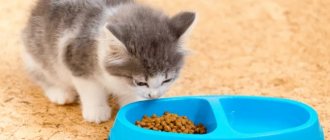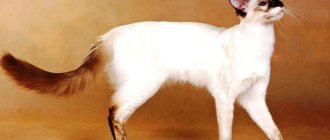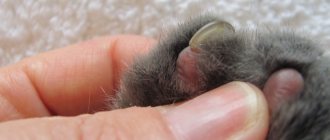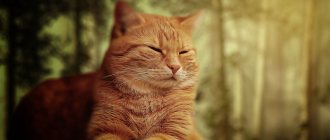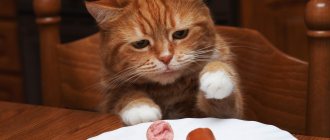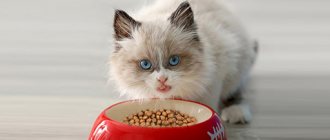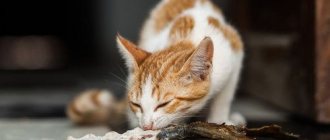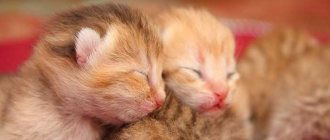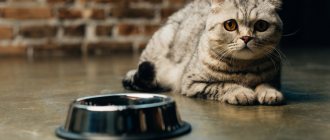Why accustom your cat to dry food?
Most kittens and adult animals are reluctant to eat granular mixtures: they are too hard to chew.
Young animals sometimes even refuse “baby” food, although the kittens’ jaws are already relatively formed and adapted for eating solid food. But animals still have to be retrained. The dry composition of good quality is prepared containing protein, taurine, fats, vitamins, which are necessary for both young animals and adults, and has a long shelf life (at least 1 month without refrigeration).
What food can you give a kitten?
Many owners are interested in the question of whether it is possible to give dry adult food to a kitten. In fact, the baby’s body requires more protein and microelements, so food for large representatives of the cat family is not suitable. Adult food contains high amounts of vitamins that can harm the baby. If you want to take care of your kitten’s health, it is better to choose specially designed food for it according to its age. You can accustom a small kitten to dry food using the same methods as an adult. For example, soaking food in warm water.
The importance of water when switching to dry food
When choosing any type of dry granules, you need to learn the basic rules and constantly adhere to them:
- The cat should have constant access to clean water. To prevent the animal from suffering from dehydration, the drinking bowl is often placed in a sink, directing a thin stream into a bowl. Drinkers standing separately on the floor should hold a volume of liquid 2-3 times greater than what the cat drinks in 1 day.
- When feeding dry kibble, the crumbs quickly contaminate the water. Picky cats will begin to ignore such drinking and will suffer from dehydration. It is advisable to replace the water in the morning and evening if the owner spends a lot of time outside the house. If it is possible to replace the contents of the drinking bowl during the day, then it is worth doing this more often.
- To quickly and gently accustom your cat to dry food, you will have to constantly monitor the availability and quality of water. If your pet feels constant discomfort from new food, it will be difficult to force him to eat hard granules.
Water is freely available
After switching to a new diet, it is extremely important to monitor the cat’s drinking regime. After all, dry food contains practically no moisture, which means that the animal needs to receive it separately. Clean drinking water should be freely available around the clock. If it becomes cloudy, replace it with a fresh one.
Sometimes the cat hardly touches the bowl of water, but he loves to drink from the tap. It is better to provide him with this opportunity, because a chronic lack of fluid due to dry feeding can lead to diseases of the urinary system. However, you should not allow animals to drink from the toilet bowl: it may contain residues of detergents and pathogens that cause poisoning.
How to start training
There are many situations in which a cat has to be switched to dry food from wet or natural food. The most difficult thing to transfer correctly is kittens: they have high water needs.
If the young animals are not separated from their parents, but have simply reached the age of 2.5-6 months, training the kitten will be easier. The same stamps are poured onto the mother and kittens, water is poured in and left. Flavoring additives attract attention, and the lack of other food and the cat’s appetite provoke small pets to want to try new food. By imitating their mother, they quickly and easily retrain.
When a kitten is taken from its mother at an early age (up to 2-3 months), the owners will have to take full responsibility for the well-being of the cub. In the first days, it is better to feed the animal with what it was given before. Introduce new complementary foods little by little; you can add them to the previous type of food.
The case for ready-to-eat feeds
Contrary to popular opinion about the dangers of dry food, a number of arguments are given in defense of this diet. Veterinarians have also long ago refuted this erroneous belief, and many owners note the following benefits:
- composition - good dry food, it is a balanced amount of proteins, fats and carbohydrates necessary for the body. The required minerals, vitamins and easily digestible fiber are also included in the product;
- risks for food poisoning are almost eliminated . The possibility of poisoning cannot be completely ruled out, however, well-known manufacturers value their reputation, and high-quality feed, especially the premium class, does not include any harmful chemical components;
- dosage - on each package of ready-made food, the recommended daily intake is always written down, taking into account the weight and age of the animal, which is convenient both for calculating portions and for purchasing the required amount for a certain period of time;
- individual needs - the ability to choose according to the characteristics of the pet: age, health status, reactions to allergens, weight, etc.;
- storage – dry food does not require special conditions, opened packaging is stored for a long time without spoiling or weathering, like natural products;
- combination - dry food can be combined with wet ready-made food, and combined with a small amount of regular food, which greatly facilitates the task of accustoming the cat to new dry food.
And it is immediately necessary to make a reservation on the last point - such a combination is permissible only in the early stages of changing the diet; further feeding does not allow mixing dry food and natural food. Failure to comply with this rule can have a detrimental effect on the health of the pet and cause serious disruptions in the functioning of the body. Therefore, frequent feeding is excluded.
General translation rules
When retraining kittens and adult cats, it takes approximately 1 week. In the first 2-3 days, the granules can be mixed, but then give 1 separate serving per day. By day 7-10, the animal should only receive pellets and water.
If you have to quickly switch your cat to dry food, it is recommended to monitor its well-being:
- If signs of intestinal pain and stool upset appear, you should take the animal to the veterinarian.
- Doctors note that urolithiasis quickly develops from constant feeding of formulas. If young animals develop dark-colored urine, it is advisable to consult a specialist.
- You cannot overfeed animals: you must follow the food standards indicated on the packages.
After wet food
If before the transfer the pet received wet pieces of food from the same line and manufacturer, it is easier to teach the cat to eat dry food. It is enough to choose a product with a similar taste and sauce, and simply mix the 2 substances for several days. The cat will gradually get used to the changing texture of the food mass.
After natural food
Difficulties often arise when feeding cats dry granules after the fish or meat that the animal was fed before. Despite flavoring additives, pets often refuse the unusual taste.
In such cases, it is easier to first accustom the animal to the wet variety, and then offer a new option.
Reasons why furry doesn't eat food
If it's not a matter of taste, then the matter becomes more serious because it could be a disorder or illness in the cat. Common gingivitis in cats can cause reluctance to eat, as well as sudden mood changes: anger in a cat makes it stop eating.
If your cat is exhibiting other symptoms along with a lack of appetite, such as apathy and aggression, as well as lethargy, it is very important that she is examined by a trusted veterinarian to check her health.
Another reason why a cat won't eat wet food is because it's rancid and smells bad, which is reason enough to remove it from the bowl for good. Keep the bowls your cat eats in clean and always check that the food is in good condition. If your cat ingests something rotten and spoiled, he may suffer from serious illnesses, such as intestinal disorders.
© shutterstock
What to do if your cat refuses dry food
The main thing that should not be done in such situations is to force animals to eat or leave them without other food if retraining has just begun.
But you can attract attention in other ways:
- You can add some of your favorite food to the new mixture. The portion can be mixed so that it only acquires a smell, or you can add more fish, liver, etc. The amount can be determined experimentally: when food becomes attractive, a hungry animal begins to become impatient and starts eating.
- Don't be afraid to mix natural and dry ingredients. Good producers prepare their feed from meat, offal, and fish of normal quality. Holistic or premium mixtures do not even cause allergies, and troubles associated with their use can be caused by improper storage (for example, getting wet and mold development).
- Soaked granules should not be left in food containers. If water gets on them, mold will develop within a few hours, and the cat (and especially young animals) can become poisoned. Before feeding again, you need to thoroughly wash the bowl and replace the water. Pour a portion of food into a dried container and feed the animals.
The cat does not want wet food: possible reasons
If you notice that your cat has changed its attitude towards wet food, it is best not to force or encourage it to eat against its will. It is necessary to understand the reason for his change, to understand the reason that pushes him to refuse this food. Read more in this article.
The cat is also known to be a complex and demanding animal, especially when it comes to nutrition. It is no secret that a cat loves to eat the food that it likes best, in terms of taste and smell, since it is also attentive to the appearance of the dishes offered by the owner. Having a cat as a furry friend puts us in a position where we are forced to please her as she pleases.
© shutterstock
In fact, it is his need that puts us in a difficult position and often creates problems in it. If your furry friend is always fussing over the dish and expects each meal to be of a different quality, his expectations can make our lives difficult and disappoint him.
The cat's taste is demanding, and this is his natural characteristic, but it may happen that he refuses the usual food that he eats every day, that is, large and wet food, and confuses us with this reaction. But why doesn't my cat want wet food? Let's try to understand why.
It may happen that we see a cat reject even the best cans of wet food on the market, and then we wonder why. We should not immediately think about the health problem of the animal; probably, the cat does not appreciate the special taste of the food that we are trying to offer it; or his refusal lies precisely in the fact that he is sufficiently satisfied with this particular food.
How to switch a cat to a balanced diet in a week?
In order for the period of food change to be as comfortable as possible, you need to set aside at least a week for it, and sometimes it may take more time. First of all, you need to purchase good aromatic food so as not to alienate the animal from a new type of food. Below is an approximate diagram of changing the nutritional diet:
- On the first day, you should take a small amount of granulated food and soak it in water. After the granules are soaked, you need to add them to a bowl with your usual food. In this way, the cat gets acquainted with the new taste and aroma that is in its bowl.
- In the next three days you need to do the same, only gradually increasing the number of granules. In addition, the food can not only be soaked in water, but also in meat and fish broth, milk, and liquid porridge.
- By the fourth day, the pet gradually adapts to the new taste, and dry food, rather than soaked food, can be added to his bowl. After the animal eats this, you can give it its usual food to reward it. If he refuses to eat balanced stones, then dry food will need to be mixed with natural food for further adaptation.
- On the fifth day, you should gradually increase the amount of dry granules and reduce the dosage of “natural”. At the same time, one circumstance remains important - clean and fresh water is always available. Since the transition from one diet to another is usually accompanied by an increased feeling of thirst.
- And only after a week can only dry granules be poured into the cat’s bowl.
During the first week of switching to granulated food, you need to carefully monitor the kitten’s stool; if problems with constipation or diarrhea begin, then you should consult a veterinarian, maybe this type of food does not suit him.
Basic rules for dry feeding cats
High-quality dry food is a complete, balanced diet. It contains all the necessary substances to keep your pet healthy and energetic. The correct diet for dry food requires compliance with the following rules:
- You can feed your cat only dry food, without mixing it with natural food. A pet's digestive system doesn't need variety. The body tends to adapt to the secretion of a certain set of digestive enzymes, reacting with gastrointestinal upset and changes in urine pH to a change in diet;
- purchase only high-quality dry food of at least premium class, and better yet, superpremium or holistic;
- ensure proper drinking regime. Drying cats require at least 20 ml of water per 1 kg of weight. For this purpose, it is advisable to place several large containers of water around the apartment. It needs to be changed at least 2 times a day;
To attract your pet to water, you can also install a drinking bowl with a fountain. This device also purifies the water and enriches it with oxygen.
Drinking fountain for cats
Do not change the brand of food without a good reason.
Cats older than six months are fed twice a day, and younger cats three times a day. The recommended daily amount is calculated based on the instructions on the package, reducing it by 10-15%.
Experienced veterinarians advise, in the absence of scales, to pour a layer of food one granule thick into a flat-bottomed bowl with a diameter of 10 cm twice a day. This amount will help avoid overeating, especially in sterilized pets.
Features of feeding dry food
Cats are predators by nature. Their digestive system is designed to digest animal protein, including chitin (wool, feathers, skin). After eating, meat or fish remain in the stomach of an adult animal for about 12 hours, exposed to hydrochloric acid and digestive enzymes. The food then gradually moves through the pylorus into the duodenum and then into the small and large intestines.
High-quality dry food is digested similarly to meat, remaining in the stomach for at least 10 hours. Therefore, the owner’s main task is not to overfeed the pet, strictly observing the dosage and frequency of feeding.
With a dry diet, it is also necessary to monitor the frequency of natural elimination, especially after sterilization (castration). If the animal does not urinate during the day, then it is urgently necessary to supplement it with water. This can be done using a syringe without a needle, pouring 10 ml of water into the mouth 5-7 times every hour. For constipation, you can put 2-3 drops of vegetable oil on your tongue or give 2 ml of freshly squeezed carrot juice.
About wet food
The composition of the wet food is completely identical to the dry food of a similar brand line. The difference is the moisture content. Dry water contains 5-7%, and wet water contains 65-75%.
Externally, wet food looks like pieces in jelly or sauce. They are packaged in jars or pouches (sealed foil).
Wet food
Feeding your cat only wet food is harmful for the following reasons:
- soft food stays in the stomach no longer than 30-40 minutes. This harms the digestive system of predators, disrupting the functioning of the pancreas;
- pieces of sticky food get stuck between the teeth, which can lead to rotting and subsequent inflammation;
- wet food tastes very attractive to cats, but they do not get enough of it, persistently asking for more. Overeating leads to obesity and cardiovascular diseases;
For healthy cats and kittens - only dry food
Feeding wet food in combination with dry food is recommended in the following cases:
- with poor appetite and slow weight gain of a young animal;
- in a weakened state after or during illness;
- cats with poor or missing teeth.
For healthy young animals with poor appetite, the following combination of dry and wet food is recommended:
- in the morning - a portion of wet food. Uneaten leftovers should be removed immediately. They quickly dry out, becoming inedible;
- after 3-4 hours - put the “drying” in a bowl;
- leave only water and grass overnight.
For weakened pets with bad teeth, wet food is combined with dry food as follows:
- within one day they give wet food 4-5 times in small portions;
- leave only water with grass at night;
- the next day, cats are fed dry food according to the standard scheme - 2 times with an interval of 8-10 hours.
